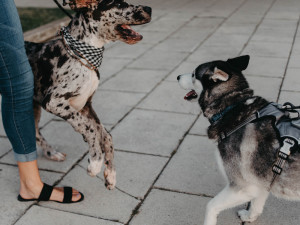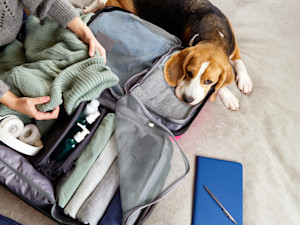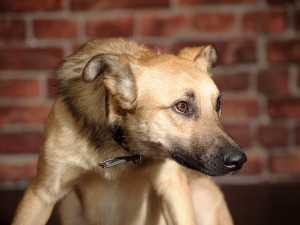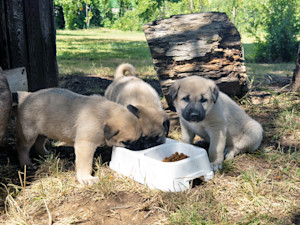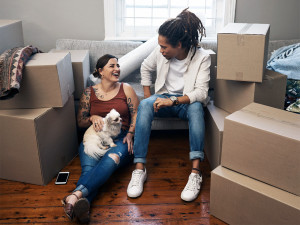Is It Safe to Stroke Stray Dogs On Holiday? Everything You Need to Consider
Before you pet that stray dog on your holiday, find out how to protect yourself and still show compassion

Share Article
Whilst on holiday, it’s hard to resist the charm of a stray dog wandering the streets of your favourite destination. Whether you’re exploring a bustling market or relaxing at a local café, you might find yourself locking eyes with a scruffy pup, tugging at your heartstrings. Many of us feel the instinct to offer a kind gesture – maybe a quick cuddle, a friendly hello or even a bit of food. The question is: is it really safe to stroke or feed stray dogs while travelling, or should we be more cautious for both our health and theirs?
Encountering a stray dog while on holiday is common; almost all of us will have found ourselves crossing paths with a kind-eyed pup at one point or another on our travels. From the regular canine locals mixing with tourists to the friendly hotel strays who greets guests with a welcome wag-on (get it?), it’s certainly hard to resist their charm.

Get (totally free) deals for food, treats, accessories, tech and way more pet parenting must-haves.
But is it safe to approach, stroke or even feed these animals, and what should you consider before doing so? How can we show compassion for the stray animals that we meet on our travels, whilst also keeping ourselves and these free-roaming pups safe in the process?
What are the health risks of petting stray dogs?
It’s not always what we want to hear, but care should always be taken when approaching a stray dog.The allure of petting a stray dog might be tempting, the potential risks can outweigh the benefits. “While it may be tempting to reach out and pet these animals, I would strongly advise against it,” says retired veterinary surgeon Dr John McKenzie Dickson.
“Stray dogs can be unpredictable and are more likely to exhibit aggressive behaviour,” he explains. However, if you find yourself in a situation where you feel compelled to stroke a stray dog, having all the information you need beforehand can help you to be aware of the potential risks involved.
“A bite or scratch from a stray dog can expose you to rabies, a viral disease that can have fatal consequences,” explains Dr Dickson. “The incubation period for rabies can be lengthy, meaning a dog that appears healthy may already be infected. It only takes a tiny scratch and a minute amount of saliva to transmit the virus.”
There are many countries with high rabies risk across Africa, Asia and South America, which you can look up online on the government websiteopens in new tab. Whilst rabies is less common in European countries, the risk is not entirely absent, however, and travellers should always exercise caution.
“Stray dogs often carry various diseases that can spread to humans. Without proper veterinary care, these animals may also harbour parasites such as ticks, which can transmit several illnesses, including Lyme disease and Rocky Mountain spotted fever,” adds Dr Dickson.
Is it safe to pet stray dogs?
Many of the stray dogs that roam the streets of holiday destinations are sweet-natured, loving and harmless, despite a sometimes tough life. However, it is always best to air on the side of caution before assuming that any dog is friendly. Whilst some stray dogs are naturally friendly and will happily come up to you, that may not always be a guarantee. Take your time and don’t rush any type of interaction, especially if the dog seems fearful of you.
When approaching a stray dog, there are many things to take into consideration. Newquay-based dog trainer James Hareopens in new tab offers some practical tips that are worth noting before getting too carried away.
“Looking at a dog’s body language is very important, whether it is stray dogs abroad or UK-based pet dogs too,” says James. “Far too often, we as humans decide we want to pet and stroke dogs because we feel it is habitual for us to do so, and that all dogs like it. This is definitely not the case. It is vital to understand how dogs will give you clear signs that they do not want to be approached, or touched.”
And he’s not wrong. A recent Dogs Trust survey found that 76 percent of respondents weren’t able to accurately identify worried dog behavioursopens in new tab. Make sure you’re away of what an anxious dog might look like, which includes:
turning the head away
whale eyes – showing the whites of their eyes
yawning
lip-licking
tail tucked under their body
physically moving themselves away
“Dogs should always be given a choice,” advocates James. “The one common misconception is that when we approach a dog, we should offer our hand to allow the dog to sniff us. In reality, the dog’s nose will already have picked up your scent long before you put your hand anywhere near it and will have made their own mind up as to whether it wants to be approached”.
How to safely interact with stray dogs
If you feel compelled to engage with a stray dog then you should always aim to do so safely. Providing fresh water and healthy treats may be tempting, but should be offered from a safe distance. We must remember that although our desire to help a stray animal is strong, we don’t know the dog, their health conditions or circumstances well enough to rush in and make snap decisions regarding their welfare.
“I never advise offering food; stray dogs are often very motivated by food but are wary of humans, due to genetics and previous bad experiences,” explains clinical animal behaviourist Emily Birchopens in new tab. “When we use food it brings the dog into a very close proximity to us which can then lead to them feeling conflicted.” It puts them at a much bigger bite risk than they otherwise would be and may cause them to panic when they realise that they are too close for comfort and need more personal space, she adds.
If you absolutely must use food, you should throw it to the dog and away from you. “At no point should you encourage them to come in close to you by using food,” says Emily. “If the dog is social and wants affection they may have places they’re OK with being stroked, such as the chest, and places they aren’t, such as the back, so pay close attention to their reactions.”
Realistically, the only real way to minimise the risk is to not actually put your hands on the dog. “Even if a stray dog wants to hang out with you, take it as a privilege that they want to be near you, and don’t always dive straight into trying to touch them,” says Emily.
Ways to help stray dogs without physical contact
Being empathetic to stray dogs is part of what makes us human. We strive to nurture and protect wounded or abandoned animals, and seeing them while on holiday often reminds us of our privilege as well as our own much-loved pampered pets back at home. Some practical ways to help make a difference, without getting too hands-on might include:
Consulting a local animal rehoming centre: many countries now try to re-home and rehabilitate stray dogs, with studies showingopens in new tab that some stray dogs have the potential to improve their sociability towards humans. This is a wonderful way for stray dogs to find their forever home and be matched with their perfect pet parent.
Donating to local dog charities and reputable shelters: donating financial aid to local charities and shelters can help keep them afloat, allowing them to continue making a difference to dogs in need.
Donating supplies: there are often local charities working across local towns and villages who will ensure that supplies such as fresh water, food and essentials are delivered safely to stray dogs in need. A quick Google search will reveal the resources in the area that you are visiting.
Speak to the locals: local residents may also be able to offer help and advice, but be aware that in some countries, stray dogs are seen as a nuisance rather than being revered in society.
There’s certainly no one-size-fits-all when it comes to knowing how stray dogs will react, but with some common sense and a mindful attitude, we can learn how to positively interact with these animals safely and respectfully as we pass through the streets and villages that through no fault of their own, have become their home.

Becky Bowden
Becky is a freelance writer based in the southwest of England where she is the proud dog mama to Cookie, the Welsh Sheepdog. Becky enjoys writing about all things entertainment and lifestyle. When she’s not writing for Kinship, you can find her contributing to publications such as Cosmopolitan, OK!, Yahoo! UK and The Telegraph.
Related articles
![three puppies eat kibble under a tree]()
Backlash Grows Against Turkey’s ‘Massacre Law’ Aimed At Street Dogs – Here’s How You Can Help
The new bill, seen as a potential death sentence for many of Turkey’s cherished street dogs, was passed in July. Activists tell us they will keep on fighting
![a woman and a man sit in an empty home surrounded by boxes with a dog]()
Moving Abroad With Your Dog? Here’s Everything You Need To Know
Moving house is stressful at the best of times, but what happens if you want to move abroad with your dog? We consulted some experts to find out
![Owner serving dog food]()
Your Dog’s Food Aggression Isn’t Cute – Here’s How You Can Work On It
No longer associate feeding time with growling time
